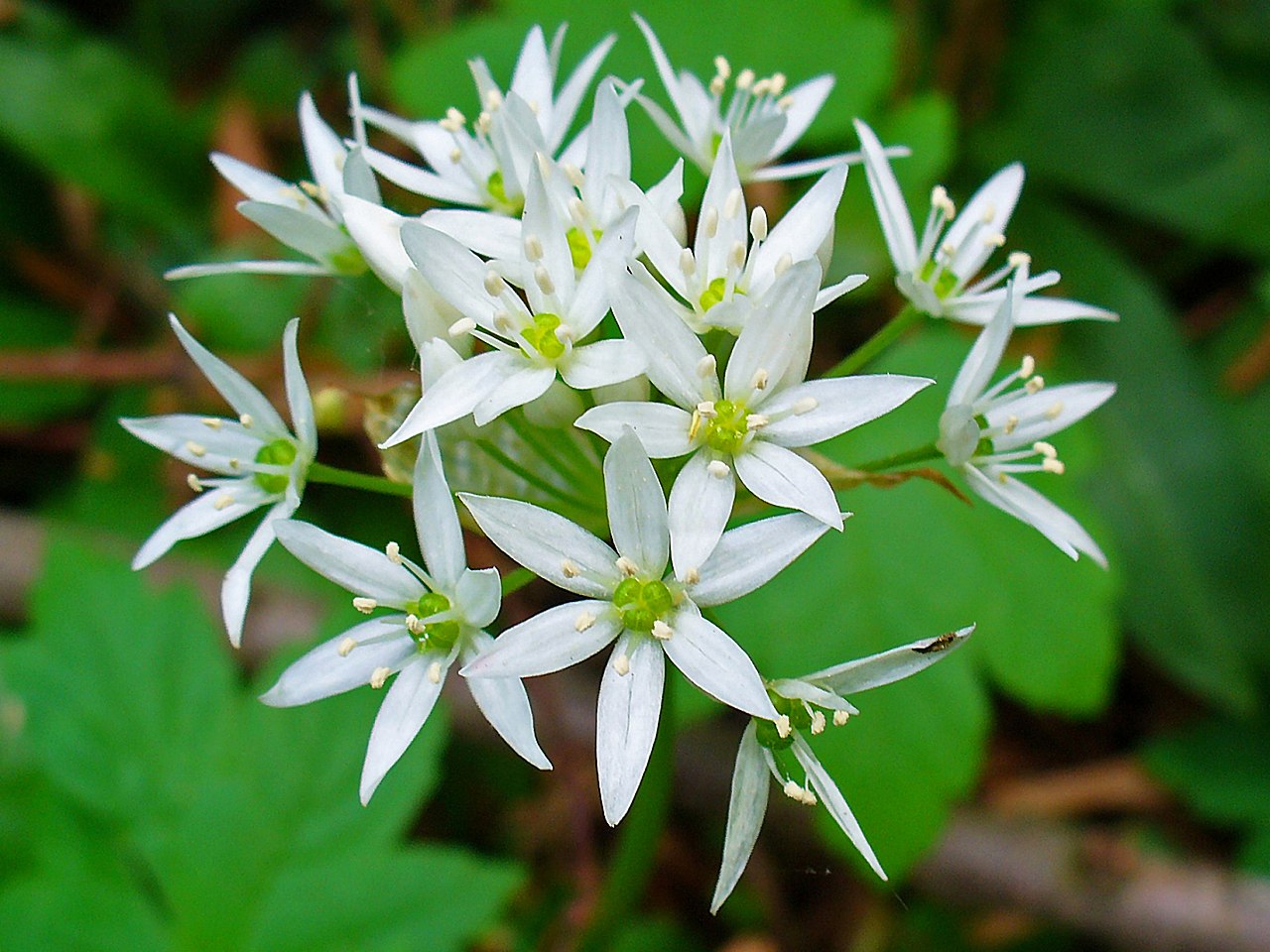
Wild Garlic Allium ursinum
Family - Amaryllidaceae – amaryllis family
Perennial bulb - up to 30 cm tall
Flowering – April to June
Soils - Most soils, acid to alkaline
Sun - Partial shade
Wild garlic goes by many local names, of which "ramsons" is the best known, but which include gypsy onion, devil's posy, onion-stinkers, snake-plant and stinking Jenny.1. It certainly lives up to its reputation, and the leaves, stem and bulb all smell and taste strongly of garlic. It was first described by Turner in 1551,2. but there is every reason to assume (and some evidence to back it) that wild garlic has been eaten by people since the Mesolithic period. The species name "ursinum" comes from its popularity with brown bears (and wild boars).
Ramsons are very attractive plants, with deep-green soft leaves like those of tulips up to 25cm long. The brilliant white star-shaped flowers are born in a loose cluster at the top of a stalk, and can make a very pleasing carpet effect when a large stand of the plant is in flower. Their bulbs are quite thin and elongate. The edible flowers make an excellent trendy garnish on a salad, and the leaves can be used as a mild substitute for garlic, and they make a sublime soup.
Ramsons were used in folk medicine. Vickery records a seventeenth century proverb: "eat leeks in March and ramsins in May, and all the yeare after physitians may play".1. He quotes a colds and coughs recipe I would like to try - fresh washed bulbs are dried and put in a jar with brown sugar and light Jamaica rum. This is stored in a dark place until winter when it is needed.
Wild garlic is visited by pollinating bumbles and honeybees. It is a foodplant for a few insects including the leaf-mining beetle Orthochaetes setiger and the ramsons hoverfly Portevinia maculata3. which eats the stem bases and bulbs.
There is a down-side to this elegant plant, in that it can be a bit of a thug, and spread extensively if it likes your garden. The RHS have a profile discussing how to deal with it.4.
References
1. Vickery, R. 2019. Vickery’s Folk Flora, An A to Z of the Folklore and Uses of British and Irish Plants. Weidenfeld & Nicolson. London. p. 558
2. Pearman, D. (2017). The Discovery of the Native Flora of Britain and Ireland, A compilation of the first records for 1670 species and aggregates, covering Great Britain, Ireland, The Channel Isles and the Isle of Man. Botanical Society of Britain & Ireland. p 92
3. Biological Records Centre database
4. RHS plant profile
Page written and compiled by Steve Head


Wild garlic goes by many local names, of which "ramsons" is the best known, but which include gypsy onion, devil's posy, onion-stinkers, snake-plant and stinking Jenny.1. It certainly lives up to its reputation, and the leaves, stem and bulb all smell and taste strongly of garlic. It was first described by Turner in 1551,2. but there is every reason to assume (and some evidence to back it) that wild garlic has been eaten by people since the Mesolithic period. The species name "ursinum" comes from its popularity with brown bears (and wild boars).
Ramsons are very attractive plants, with deep-green soft leaves like thos of tulips up to 25cm long. The brilliant white star-shaped flowers are born in a loose cluster at the top of a stalk, and can make a very pleasing carpet effect when a large stand of the plant is in flower. Their bulbs are quite thin and elongate. The edible flowers make an excellent trendy garnish on a salad, and the leaves can be used as a mild substitute for garlic, and they make a sublime soup.
Ramsons were used in folk medicine. Vickery records a seventeenth century proverb: "eat leeks in March and ramsins in May, and all the yeare after physitians may play".1. He quotes a colds and coughs recipe I would like to try - fresh washed bulbs are dried and put in a jar with brown sugar and light Jamaica rum. This is stored in a dark place until winter when it is needed.
Wild garlic is visited by pollinating bumbles and honeybees. It is a foodplant for a few insects including the leaf-mining beetle Orthochaetes setiger and the ramsons hoverfly Portevinia maculata3. which eats the stem bases and bulbs.
There is a down-side to this elegant plant, in that it can be a bit of a thug, and spread extensively if it likes your garden. The RHS have a profile discussing how to deal with it.4.
References
1. Vickery, R. 2019. Vickery’s Folk Flora, An A to Z of the Folklore and Uses of British and Irish Plants. Weidenfeld & Nicolson. London. p 558
2. Pearman, D. (2017). The Discovery of the Native Flora of Britain and Ireland, A compilation of the first records for 1670 species and aggregates, covering Great Britain, Ireland, The Channel Isles and the Isle of Man. Botanical Society of Britain & Ireland. p 92
3. Biological Records Centre database
4. RHS plant profile
Page written and compiled by Steve Head
Wild Garlic Allium ursinum
Perennial bulb - up to 30 cm tall
Flowering – April to June
Soils - Most soils, acid to alkaline
Sun - Partial shade




- Home
- Wild Plants
- Top wildflowers
- Shade plants
- Wild garlic






